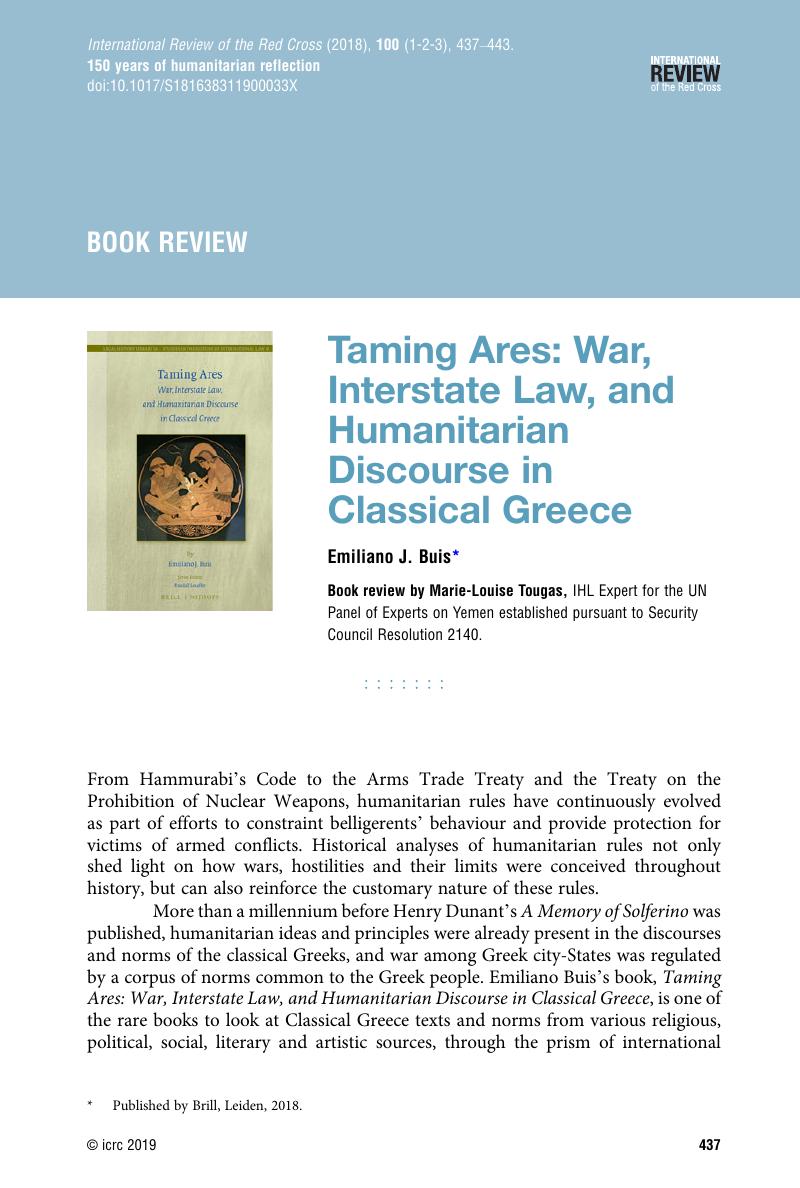No CrossRef data available.
Published online by Cambridge University Press: 18 July 2019

Published by Brill, Leiden, 2018.
1 Taming Ares, p. 104.
2 Ibid., p. 72, note 65, quoting Thucydes.
3 Ibid., p. 76.
4 Ibid., p. 81.
5 Ibid., p. 82.
6 Indeed, this echoes the criticisms often levelled in recent years against the United Nations system and the role given to the five permanent members of the Security Council. On this issue, see, for instance, Nadin, Peter, UN Security Council Reform, 1st ed., Global Institutions Series, Routledge, London, 2016CrossRefGoogle Scholar.
7 See Taming Ares, pp. 126–127. The author quotes a passage from Aristotle's Politics: “The proper object of practising military training is not in order that men may enslave those who do not deserve slavery, but in order that first they may themselves avoid becoming enslaved by others.”
8 Ibid., pp. 128–131.
9 Ibid., p. 138.
10 The principles of IHL are based on a balance between considerations of humanity and of military necessity: see Melzer, Nils, International Humanitarian Law: A Comprehensive Introduction, ICRC, Geneva, 2016, p. 17Google Scholar. See also, for instance, Schmitt, Michael N., “Military Necessity and Humanity in International Humanitarian Law: Preserving the Delicate Balance”, Virginia Journal of International Law, Vol. 50, No. 4, 2010Google Scholar.
11 See Taming Ares, p. 149.
12 See, in particular, ibid., p. 146 ff. The principle of distinction is the cornerstone of IHL. See N. Melzer, above note 10, p. 18; Henckaerts, Jean-Marie and Doswald-Beck, Louise (eds), Customary International Humanitarian Law, Vol. 1: Rules, Cambridge University Press, Cambridge, 2005CrossRefGoogle Scholar (ICRC Customary Law Study), Rule 1, available at: https://ihl-databases.icrc.org/customary-ihl/eng/docs/v1 (all internet references were accessed in May 2019).
13 Non-hostile contact between parties to conflict, especially through the use of parlementaires is a long-established rule of IHL, as is the inviolability of parlementaires and the protection of the use of the white flag of truce. See ICRC Customary Law Study, above note 12, Rules 58, 66, 67.
14 See Taming Ares, p. 172. In 1977, Additional Protocols I and II to the Geneva Conventions set the minimum age of recruitment in armed forces at 15 and prohibit participation of children below that age in hostilities: see Additional Protocol I (AP I), Art. 72(2), and Additional Protocol II (AP II), Art. 4(3)(c). The Convention on the Rights of the Child (UNGA Res. 44/25, Annex, UN Doc. A/44/49, 1989 (entered into force 2 September 1990)) also contains a similar disposition in its Article 38. The Optional Protocol to the Convention on the Rights of the Child on the Involvement of Children in Armed Conflict (UNGA Res. 54/263, Annex I, UN Doc. A/54/49, Vol. III, 2000 (entered into force 12 February 2002), Arts 1, 2) raises this threshold to 18 years old. This rule is recognized as a customary rule: see ICRC Customary Law Study, above note 12, Rules 136, 137.
15 See Taming Ares, p. 173 ff. Cultural properties are protected by IHL: see AP I, Art. 53(1); AP II, Art. 16; and the Hague Convention on the Protection of Cultural Property (1954) and its Protocols (1954 and 1999). The protection of cultural property is also a rule of customary IHL: see ICRC Customary Law Study, above note 12, Rules 38–41.
16 See Taming Ares, p. 179. The same idea is behind the prisoner-of-war status and the combatant privilege granted by IHL: see, among others, N. Melzer, above note 10, p. 175.
17 See Taming Ares, p. 179.
18 Passage reproduced in Greek and English in ibid., p. 180. See also p. 181.
19 Ibid., p. 184,
20 Ibid., p. 185.
21 See ibid., pp. 190–200. For more details, see Buis, Emiliano J., “Hyendo a Argos: La proteccionjuridica de las mujeres refugiadas y el lenguaje del humanitarismo griego en Supplicante de Esquilo”, in Grignon, Julia (ed.), Tribute to Jean Pictet, Editions Blais, Yvon, Montreal, 2016, p. 153Google Scholar.
22 Taming Ares, pp. 203–208. IHL prohibits the use of biological weapons. See Convention on the Prohibition of the Development, Production and Stockpiling of Bacteriological (Biological) and Toxin Weapons and on Their Destruction, 10 April 1972; Protocol for the Prohibition of the Use of Asphyxiating, Poisonous or Other Gases, and of Bacteriological Methods of Warfare, Geneva, 17 June 1925. This is also a customary rule: see ICRC Customary Law Study, above note 12, Rule 73. IHL also protects objects that are indispensable to the survival of the civilian population such a water: see AP I, Art. 54(2); AP II, Art. 14; ICRC Customary Law Study, above note 12, Rule 54.
23 Plato in Twelve Volumes, trans. Shorey, Paul, Vols 5–6, Harvard University Press, Cambridge, MA, and William Heinemann, London, 1969Google Scholar, reproduced, along with the Greek version, in Taming Ares, p. 172.
24 Taming Ares, pp. 217–220.
25 Aristotle in 23 Volumes, trans. Rackham, H., Vol. 20, Harvard University Press, Cambridge, MA, and William Heinemann, London, 1952Google Scholar, reproduced, along with the Greek version, in Taming Ares, p. 223.
26 The Martens Clause was first introduced in the preamble of Hague Convention (II) on the Laws and Customs of War on Land in 1899. See International Court of Justice (ICJ), Corfu Channel Case (United Kingdom v. Albania), Judgment (Merits), 9 April 1949, ICJ Reports 1949, p. 22; ICJ, Case concerning Military and Paramilitary Activities in and against Nicaragua (Nicaragua v. United States of America), Judgment (Merits), 27 June 1986, para. 218; ICJ, Legality of the Threat or Use of Nuclear Weapons, Advisory Opinion, 8 July 1996, paras 78, 84, 87. See also Zagor, Matthew, “Elementary Considerations of Humanity”, in Bannelier, Karine, Christakis, Theodore and Heathcote, Sarah (eds), The ICJ and the Evolution of International Law: The Enduring Impact of the Corfu Channel Case, Routledge, London, 2012Google Scholar.
27 Cassese, Antonio, “The Martens Clause: Half a Loaf or Simply Pie in the Sky?”, European Journal of International Law, Vol. 11, No. 1, 2000, p. 212CrossRefGoogle Scholar.